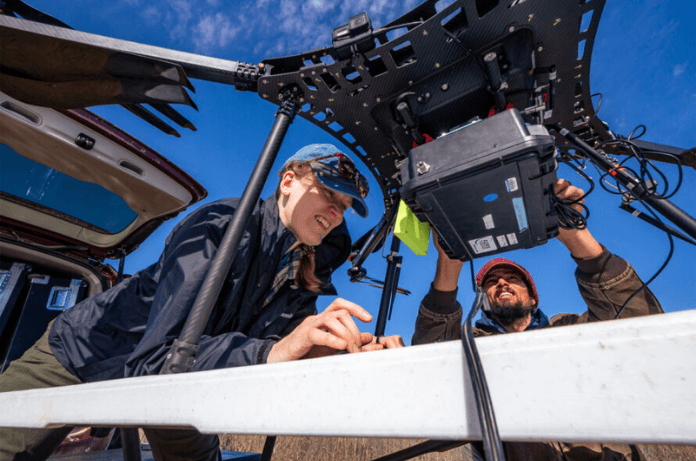Scattered across the United States are remnants of nearly 170 years of commercial oil and gas drilling: hundreds of thousands of forgotten wells. These undocumented orphaned wells (UOWs) remain unlisted in formal records, with no known or financially solvent operators to manage them. Often out of sight and out of mind, these wells pose significant environmental risks, such as contaminating water sources, emitting toxic chemicals like benzene and hydrogen sulfide, and leaking methane, a greenhouse gas 28 times more potent than carbon dioxide at trapping heat in our atmosphere on a 100-year timescale.
To tackle this issue and measure methane, researchers are turning to cutting-edge modern tools, including drones, laser imaging, and suites of sensors. However, with the contiguous United States spanning over 3 million square miles, the task is monumental. To predict the locations of these undocumented orphaned wells, researchers are pairing modern technologies such as AI with historical data, including old topographic maps.
Merging AI with History to Find Forgotten Wells
“AI can enhance our understanding of the past by extracting information from historical data on a scale that was unattainable just a few years ago,” said Fabio Ciulla, a postdoctoral fellow at the Department of Energy’s Lawrence Berkeley National Laboratory (Berkeley Lab). Ciulla is the lead author of a study on using AI to find UOWs, recently published in the Journal for Environmental Science & Technology.
Since 2011, the United States Geological Survey (USGS) has digitized 190,000 historical topographic maps, made between 1884 and 2006, and geotagged them for easy reference. Ciulla and his team used these maps to identify oil and gas wells marked by hollow black circles. For decades, human analysts relied on manual identification, but this method does not scale well when analyzing thousands of maps.
To overcome this limitation, researchers trained an AI algorithm to recognize these well symbols. They created a training set by manually marking wells on nearly 100 maps from California, teaching the AI to distinguish well symbols from false positives, such as cul-de-sacs or symbols with circular patterns, like the number 9 or letter “O.” The AI then analyzed maps at scale, identifying undocumented wells with remarkable accuracy.
Narrowing Down Potential Wells
Using this approach, researchers focused on 4 counties with significant early oil production: Los Angeles and Kern counties in California, and Osage and Oklahoma counties in Oklahoma. The AI identified 1,301 potential undocumented orphaned wells.
So far, 29 UOWs have been verified through satellite imagery, and 15 through field surveys. Researchers used a 100-meter buffer zone to minimize errors in well coordinates and employed a custom tool for human review, ensuring the AI’s findings were accurate.
“We intentionally chose to have more false negatives than false positives,” said Charuleka Varadharajan, a scientist at Berkeley Lab and senior author of the study. “We believe the number of wells we’ve found is an underestimate, and further refinements could reveal even more.”
Verifying Wells in the Field
Verification begins remotely, with researchers analyzing satellite images and historical aerial photos for signs of well infrastructure, such as oil derricks, pump jacks, or storage tanks. In many cases, wells were capped at or below the surface level and left no visible markers.
To confirm these wells in the field, researchers use magnetometers to detect buried metal well casings. They walk grid or spiral patterns over the site, record magnetic field disturbances, and save GPS coordinates for the wells they locate. Methane leaks are also checked at each site, further emphasizing the environmental stakes of finding these wells.
Scaling the AI Approach
For the wells verified by the Berkeley Lab team, the UOWs were found an average of 10 meters from their predicted locations. This AI-driven approach is believed to be the first capable of identifying precise well locations at a county scale. With access to the extensive USGS map archive, researchers plan to expand this method to other regions across the United States.
This mapping and verification initiative is part of the Consortium Advancing Technology for Assessment of Lost Oil & Gas Wells (CATALOG). This collaborative project, led by Los Alamos National Laboratory, includes contributions from Berkeley Lab, Lawrence Livermore National Laboratory, Sandia National Laboratories, and others.
A Nationwide Problem
In 2021, the Interstate Oil and Gas Compact Commission estimated that there will be 310,000 to 800,000 undocumented orphaned wells in the United States. These wells represent a sprawling environmental challenge, and AI is proving to be an invaluable tool in addressing it.
The Path Forward
While researchers have made significant strides in uncovering these forgotten wells, there is much work ahead. By integrating advanced technologies with historical data, teams like those at Berkeley Lab are paving the way for a more comprehensive understanding of UOWs and their environmental impact.
Call to Action: Addressing the Legacy of Forgotten Wells
The story of undocumented orphaned wells underscores the importance of blending modern technology with historical insights to tackle environmental challenges. As researchers refine their methods and expand their efforts, the question remains:

